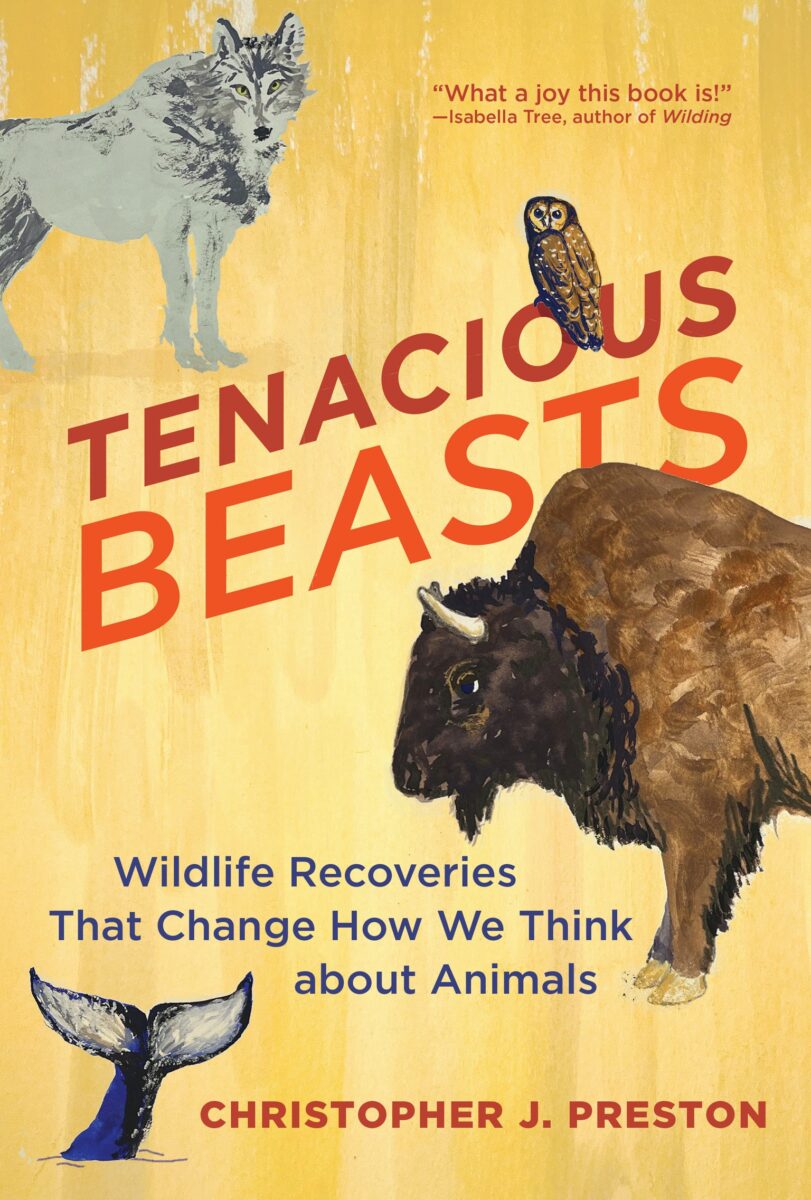Kalispell Museum Hosting University of Montana Professor for Talk on New Book About Wildlife Recoveries
Christopher J. Preston’s book, “Tenacious Beasts: Wildlife Recoveries That Change How We Think About Animals,” was released in February
By Mike Kordenbrock
A University of Montana environmental philosophy professor who believes humans need a new way to think about animals will be delivering a free talk May 4 at the Northwest Montana History Museum. His recently published book also illustrates the lessons that can be learned from species that have survived changing times, and a changing climate.
Christopher J. Preston’s book, “Tenacious Beasts: Wildlife Recoveries That Change How We Think About Animals,” was released in February by MIT Press, and focuses on animal life in the United States and Europe, including in Montana, where Preston delves into the efforts to grow the state’s bison population and some of the complex questions about the animals’ genetic makeup as it relates to those efforts. In explaining the geographic parameters to his work, Preston concedes that nothing about animal recoveries in those specific areas is “unique to these locations,” but he writes that Europe, by way of Southern England, is where he grew up, and the United States is “where I am growing old.”
In explaining the layout of his book, Preston writes in his introduction that it explores a number of wildlife recoveries, and seeks to reveal how certain animals “have bucked the larger trend.” Sections of the book also align with the essential change in attitude that each recovering species demands.
The book “asks how things can go so right when so much is going wrong,” Preston writes.
But he also takes pains to emphasize the gravity he sees in the challenges to wildlife presented by climate change, increased consumption, habitat loss and the spread of non-native species.
“For every success, there are ten cases of continuing decline,” Preston writes, continuing a few sentences later with the declaration that “this book is not designed to provide soothing reassurances about wildlife. Animal populations are not out of danger. Their outlook remains dire.”
At the same time, the author suggests that there is a value in examining these stories both in the hope they may provide, and their potential to help develop that new way of thinking about animals that the book seeks to promote.
“The return of animals demands something from us. Wildlife challenge entrenched ways of thinking and shake us from well-worn habits of mind. They teach us better ways of being in the world,” Preston writes. “This is no longer the nineteenth century, when industrializing nations felt entitled to exploit wildlife as they saw fit. Humans possess a range of new tools and an assortment of new desires. If wild animals are to flourish in twenty-first-century landscapes, a different set of attitudes must take hold. We need a better way to think about wildlife. The chapters ahead contain plenty of ecological details. But they also hint at a philosophy, a roadmap to a future state of mind.”
Margaret Davis, the director of the Northwest Montana History Museum, said that she’s excited for the event with Preston, and noted that his book is already on its second printing. The New Yorker called it a “lively study” on animal resurgences in an era of mass extinction. Publisher’s Weekly described the book as a containing “surprisingly intimate accounts of species bouncing back from the brink of extinction” that “serve as glimmers of home against the backdrop of climate despair.”
“This will hearten nature lovers,” the review concludes.

Davis said she’s especially looking forward to hearing from Preston because of the ways in which living in this corner of Montana brings one into close contact with wildlife.
“I’ve had the bear in my driveway, I’m sure like a lot of folks around here who have seen wildlife come back, sometimes inconveniently, and all the pressures that are faced,” Davis said. “So I’m curious, as I hope many people will be, about how he intends to talk about it.”
Preston is the 2023 winner of the International Society for Environmental Ethics award for his work as a philosopher, and has written for The Atlantic, Smithsonian Magazine, Discover, The Conversation, The Wall Street Journal, Philosophical Salon, Aeon, Lithub, Slate, and the BBC. He is also the author of “The Synthetic Age: Outdesigning Evolution, Resurrecting Species, and Reengineering Our World.”
Davis said that the Preston’s talk will start at 6:30 p.m. Thursday night and could run for about an hour, and that there will be additional time afterwards for discussion, book signing, and socializing.
Beyond bison in Montana, “Tenacious Beasts,” also looks more closely at recovering wolf populations in Europe, the interrelatedness of salmon, dams and beavers and how they relate to human management of complex systems, and the question of when animals like owls, bears and wildcats should be left alone, and when they shouldn’t be.
In one section of the book called “Ocean Partners” Preston looks at the ways in which humpback whales and sea otters might be considered partners in a battle against climate change. He starts by looking into research exploring the role of whales in nutrient transportation throughout ecosystems, which leads to broader questions about how megafauna move nutrients across ecosystems on land and through water.
Referencing the research of a University of Vermont conservation biologist Joe Roman, Preston writes of the ways that animals can move nutrients.
“Moose dunk their heads to graze the bottom of ponds and then move those nutrients onto land. Seabirds wing them from ocean to shore by eating at sea and nesting on cliffs and beaches. Migratory fish such as salmon and striped bass ship nutrients inland when they leave the ocean and ascend a river to spawn. Bears, mink, and vultures take the nutrients packaged in these fish and move them out of the streams and into the forest. Wildlife use their muscles to lift nutrients across boundaries that gravity would never permit. They heave the constituents of life from place to place before gifting them to their surroundings when they defecate or die.”
Amid this broader field of play when it comes to nutrient transportation, Preston writes that “the most generous animals in this planetary gift economy could well be the great whales.”
Later in the same section, Preston looks into whales as a method of carbon capture, and examines the work of Australian researcher Trish Lavery, who calculated that twelve thousand sperm whales create a net carbon sink of about 200,000 metric tons. “Sperm whales, in other words, are like rain forests in their ability to keep carbon out of the atmosphere,” Preston writes. “The reduction in sperm whale populations by whaling meant tons of carbon going into the atmosphere each year instead of sinking toward the ocean floor.”
This leads to Preston suggesting that the survival of whales overlaps with human interests, and that for those seeking a shift in attitudes towards wildlife it might be beneficial to think of whales as “partners in the climate change struggle.”
“We don’t of course, get the chance to talk strategy with whales. Yet we are clearly on the same team. Allowing whales to multiply is good climate policy,” Preston writes. “This different framing earns whales a new type of ethical consideration, one I was beginning to see has promise for relations with other species of recovering wildlife.”
Preston’s talk is scheduled to start at 6:30 p.m. on May 4 at the Northwest Montana History Museum.